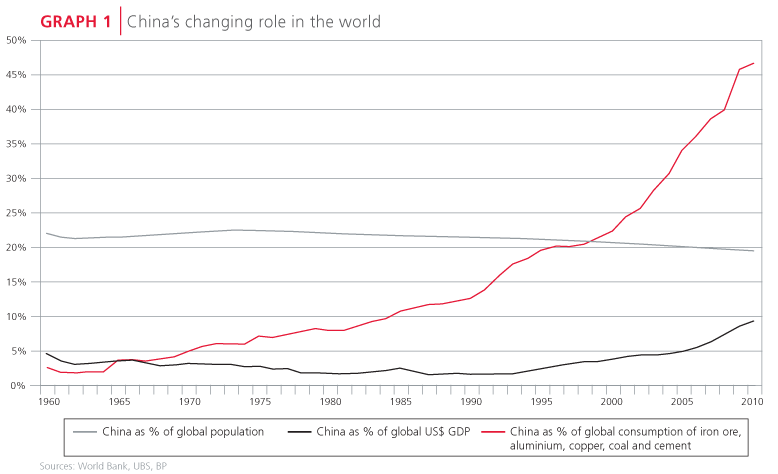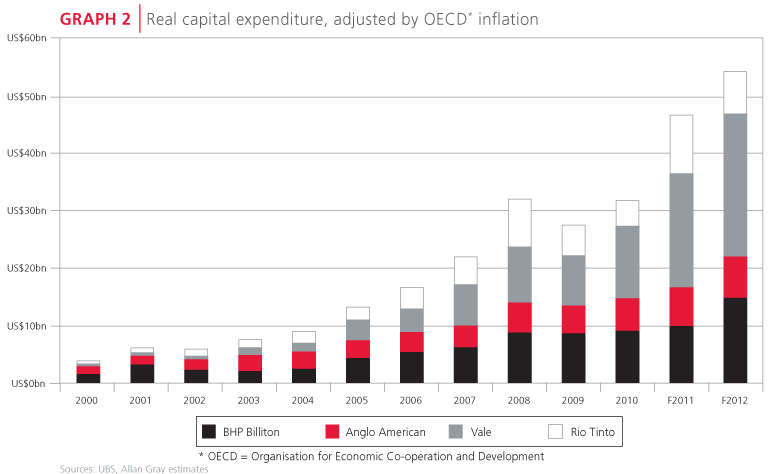In Quarterly Commentary 1, 2011 Sandy McGregor discussed how high commodity prices are being supported by the mining sector's inability to keep pace with China's demand for energy and raw materials. Mark Dunley-Owen discusses the counter-argument.
On a recent visit to China I was surprised both by the number of unfinished buildings as well as the lack of activity to complete them. A colleague counted more than 300 construction cranes along a 150 kilometre stretch of highway, of which only six were visibly operating. One wonders whether these buildings will be finished, who will buy them if they are, and if not what will happen to commodity prices.
Is China's commodity demand sustainable?
Graph 1 shows China's changing role in the world over the last 50 years. Despite quadrupling its share of world GDP over the last 15 years, it remains relatively poor with only 9% of global GDP from its 20% of the global population. What is more remarkable is that China consumed 46% of a global commodity basket to generate its 9% of global GDP. China is using five times more of these commodities per unit of GDP than the global average, which is higher than most, if not all, historical precedents.

Typically, the further one moves from the mean, the more extreme the correction. China's commodity consumption should be no different. Some argue that high commodity intensity is normal for developing countries going through a building phase. This assumes China is building the right number of the right things. Many countries have failed to achieve a similar goal and it is unclear why China should be more successful. Arguably, the risks are higher in China given its highly planned economy that incentivises growth over profitability.
Take for example the property market. According to the National Bureau of Statistics, 3.8 billion square metres of residential property was under construction in China at the end of 2010. Chinese official statistics are often disputed, but analysing China's 2010 cement consumption suggests that this figure is accurate. To put this into context, more square metres of residential property are currently being built than have been completed cumulatively over the last eight years.
There is nothing wrong with building lots of housing provided fundamental demand justifies it. In China's case, 'only' one billion square metres of residential floor space was sold during 2010. This equates to about 11 million housing units or between 5% and 10% of China's urban housing stock, which sounds reasonable. This suggests that a sustainable level of residential property construction in China is a similar one billion square metres per year, or less than one-third of the current level.
Property markets seldom tolerate excess for long. China's level of construction will slow if it cannot sell what it builds. As this happens, global commodity demand will also slow.
CHINA CONSUMED 46% OF A GLOBAL COMMODITY BASKET TO GENERATE ITS 9% OF GLOBAL GDP
Could commodity supply grow faster than demand?
We are not China experts and may be wrong about Chinese demand. Even so, commodity prices will not remain at current levels if supply grows faster than expected.
Most forecasts extrapolate poor historical supply growth into the future. This is unlikely to happen while commodity prices offer abnormal profits. At current prices, many iron ore mines break even in less than 18 months, and thereafter earn abnormally high returns. Other commodities are less profitable but still attractive. The rational response is for miners to invest large amounts of capital to grow supply to capture these profits.
Graph 2 shows the combined capital expenditure for four of the big global miners, namely BHP Billiton, Anglo American, Vale and Rio Tinto, over the last decade. The rise in money spent on future growth is impressive. The group expects to invest US$54 billion next year, the same amount in today's money that was cumulatively invested between 2000 and 2005. Although rising capital costs mean one dollar of investment buys less today than it did 10 years ago, the amount of money being spent suggests mining supply should grow strongly over the next few years.
Consider iron ore and copper. Prices of both are above their long-term averages as recent supply has struggled to keep up with Chinese demand. The market expects this to continue, yet iron ore projects already under construction are forecast to add one-third to existing supply. Similarly identified new copper mines could grow copper supply by 50%, on top of growth at existing mines. Geological and logistical constraints mean not all of this supply will be delivered, but some will. Unless China's demand continues to grow from already elevated levels, prices will fall.
Consensus views on current commodity prices seem to be anchored around recent history and do not factor in demand and supply risks. These risks may not imply an imminent crash but do favour caution.
